We welcome the sportiest MINI in the range
The new MINI Coupe joins our fleet. It looks great but will it deliver the same enjoyment when fitted with a diesel engine?
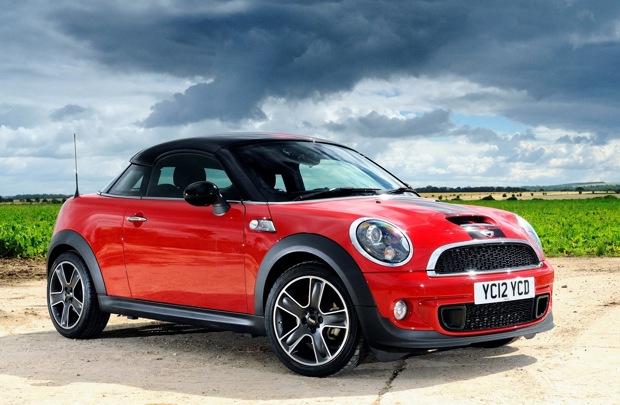
Date: 30 July 2012 | Current mileage: 800 | Claimed economy: 65.7mpg | Actual economy: 51.2mpg
The ‘new’ MINI, in one form or another, has been around for more than ten years. 2008 saw a refreshed model which, despite looking very much the same, was mechanically all-new. The hatchback model has become very popular but that hasn't stopped MINI from coming up with additional variants stir up even more interest.
First there were the Clubman and the Convertible versions followed by the recent Countryman. And now there's the Coupe along with the Roadster - essentially the soft-top Coupe. Yes, it's a bit confusing. And branching out further there's even the Clubvan (a van version of the Clubman) on the way.
In my opinion, the Coupe is the most striking model in the MINI range, with a distinctive low roofline the most obvious styling touch. It’s so striking, in fact, that on its first journey out I was stopped and photographed by a pedestrian. There’s constant head turning and pointing wherever the car goes.
But MINI is keen to promote the Coupe as more than just a prettier (or more unique) version of the hatchback. Instead it wants it to be seen as a real sports car. It certainly feels like one. The seating position feels very low, with the long, sloping windscreen adding to the experience.
There are four models starting with the Cooper which has a 1.6-litre petrol engine with 122PS. The Cooper S uses the same engine but with 184PS while the top John Cooper Works is further boosted to 211PS. There's one diesel - the 2.0-litre Cooper SD with 143PS. Most of my journeys are 30 miles or more on the motorway, with plenty of A and B roads, so the fuel economy figure of 65.7mpg and peak torque of 305Nm make the diesel the most sensible choice.
MINI is well known for the amount of customisation options on offer and it’s possible to spend hours on the MINI website configuring cars in the perfect combination of colour and specification.
Our MINI is Chilli Red with black stripes and black wheels. The black headlight surrounds, which really add to the high contrast appearance, come when xenon headlights are specified. There are a few other options meaning our car has a full-colour screen with sat nav, Bluetooth connectivity for music and phone, aux and USB-in, climate control and heated seats.
Unfortunately, having such a broad range of optional extras and customisation options means it can be fairly tricky to stick to a budget when buying – our car has more than £3000 worth of extras. Spending so much is not a bad thing to do, though, because when the time comes to sell, those extras will make your car more desirable and more valuable.
After that initial payout though, running costs should be fairly low. The Cooper SD diesel model emits 114g/km of CO2, so it’s in VED band C, currently £30 a year to tax. So far it has delivered above 50mpg, without showing any signs of dropping.
But can a car touted as being the sportiest model in an already fun-to-drive range really deliver enjoyment with a diesel engine under the bonnet? Over the six months we’ll find out if the MINI Coupe Cooper SD can deliver the perfect blend of fun and frugality.
A sporty diesel?
MINI is calling the Coupe a 'sports car' - but can it really be a sports car when it's fitted with a diesel engine?

Date: 13 August 2012 | Current mileage: 1326 | Official economy: 65.7mpg | Actual economy: 51.7mpg
MINI is calling the Coupe its sportiest model – and it’s easy to see why. In JCW or Cooper S forms it has a growling exhaust note and very brisk performance. But ours is a Cooper SD model which means it’s a diesel. Can it really call itself a sports car?
Pushing the start button doesn’t give the best impression. There’s noticeable clatter from the engine as it starts up and it’s even louder outside. Moving off shows that first gear is a little short and you’ll quickly need to move into second gear – but after that any worries about performance are quickly eased. Providing you keep the needle in the torque band, the Cooper SD engine provides surging performance.
Like any diesel there’s no use taking the engine to the red line before changing up, because it’s a waste of energy. There’s plenty of performance on tap and overtaking is effortless. The official 0-62mph figure is 7.9 seconds, but that doesn’t really do the car justice, because when you’re out on the road it feels much faster.
It’s great through bends too. The steering is immediate and precise, so you can turn into a corner with confidence. The suspension is well set up so there’s minimal body roll in bends and while it’s very firm it's communicates the road surface through the floor and seat in a noticeable but not uncomfortable way.
It makes for a great combination, so driving along a country lane is enjoyable – only the most broken of surfaces upsets its composed nature. There’s a Sport button which adds a little more weight to the steering and makes the throttle sharper.
But the Cooper SD is a car of compromise. A petrol powered Cooper S or JCW is more involving and exciting – the lighter petrol engine makes for a nimble ‘feel’ to the steering. But what the diesel engine lacks in character it makes up for in everyday usability, delivering impressive fuel economy. So far our car is averaging 51.7mpg.
And regardless of the engine, the MINI Coupe feels special. There's an electrically operated rear spoiler that raises at 50mph and it attracts attention, even on the busy streets of London, where there are scores of distinctive cars on the road. So if a ‘sports car’ is defined by performance, enjoyable handling and that ‘x-factor’ then yes, the MINI Coupe Cooper SD, regardless of its diesel engine, fits the bill.
Get Connected
Our MINI Coupe has the MINI Connected system which adds numerous extra features for iPhone users. But is it worth the extra or is it a gimmick?
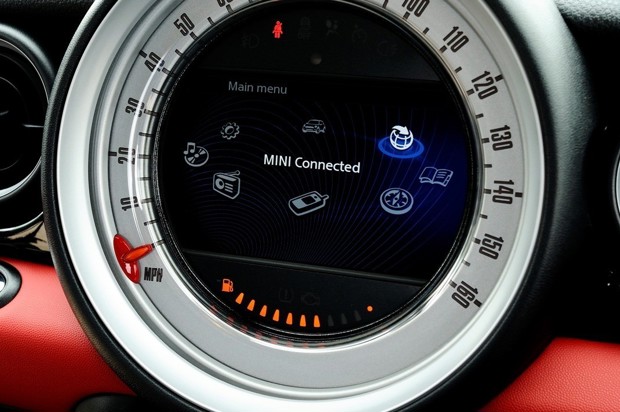
Date: 31 August 2012 | Current mileage: 3242 | Claimed economy: 65.7mpg | Actual economy: 51.6mpg
Our MINI Coupe has a big screen in the middle of the dash, which controls many functions and features. You can set how long follow-me-home lights stay on for, plan a sat nav route, control a phone, connect to media player or make use of an enhanced set of features called MINI Connected – but only if you have an iPhone.
This posed a problem for me, because I use an Android phone – a Samsung Galaxy. MINI technicians are working on an Android version of the Connected app, but no dates have been announced. In the mean time you’re stuck if you don’t have an iPhone. Or so I thought. But after a bit of cunning I managed to access the full Connected feature set via an iPod Touch, something far less expensive than an iPhone.
After installing the MINI Connected app on the iPod it’s possible to use a portable WiFi hotspot, such as one from an Android phone, to connect the iPod to the web, which means you can take advantage of the full set of MINI Connected features when on the go. That means access to Facebook and Twitter anywhere, although the functionality is limited, probably for safety reasons. You can also connect to RSS feeds and catch up with news plus so you can keep your eyes on the road, an onboard voice will read stories out to you.
There are games to play in order to spice up longer journeys. You can play a ‘Minimalism’ game, which requires you to use gentle acceleration and brake inputs to help a fish stay in his bowl and maximise your fuel economy by scoring a star rating over the duration of your trip. There’s also an app to show the ‘health’ of the car, with oil temperature and other information. You can even check your fuel level when you’re away from the car, because the information is saved when you disconnect the iPod or phone.
MINIs are supposed to be fun though, so there’s also an app called ‘driving enjoyment,’ which displays what G forces are affecting the car and in what direction. You can even pick out a good route on Google maps and send it straight to the car – when you sync the iPod or phone to the car it’ll save the route to the sat nav.
There’s also web-radio, which lets you listen to stations from all over the world. These features are fun and generally work pretty well, but the web radio does tend to drop signal quite often and if you use MINI Connected a lot it’s probably worth checking your phone battery and your data tariff, because it’ll take its toll on both!
MINI Connected is just one small part of the infotainment system installed in our MINI. It also includes an excellent Bluetooth system that allows you to connect both a phone and a media player, an accurate and easy to use sat nav system and various minor controls, covering everything from door locks to lighting.
It’s all controlled from a dial by the handbrake and is intuitive to use. It’s a similar system to the iDrive seen in BMW cars, which is no coincidence because it’s basically the same, albeit with a MINI outfit on.
The system installed on our car was part of the £1015 media pack, which includes the screen, sat nav, Bluetooth preparation and the MINI connected system. It sounds pretty expensive on paper, but having used it to navigate around the country, listen to music and connect to the web I can safely say it's money well spent – life without it would be very frustrating!
![]()
Double distinction
There are plenty of rivals for the MINI Coupe, but there's only one that's quite so distinctive - the Peugeot RCZ. So how do the two compare?

Date: 20 September 2012 | Current mileage: 3634 | Claimed economy: 65.7mpg | Actual economy: 51.7mpg
There are plenty of sporty coupes on the market, the majority of which are petrol. That’s not to say there are no diesel options – there's the Audi TT, Astra GTC and Volkswagen Scirocco – but only the TT has the true sports car profile, and to get a diesel you have to spend quite a lot.
So if you’re in the market for a sporty diesel coupe for up to about £25,000 then you’re stuck with the MINI, right? Well, not quite – there’s also the Peugeot RCZ. It has a slightly higher list price than the MINI, at £23,045 for a Sport HDI versus £20,510 for a Cooper SD, but when you’ve ticked all the boxes you want on the MINI you’ll be at about the same price as the well-equipped Peugeot.
When you take that into consideration, it makes the RCZ and the MINI Coupe pretty close rivals – and on first impressions the RCZ edges out an early lead with its sleek, elegant lines and pretty ‘double bubble’ roof. To these eyes it’s certainly the most beautiful of the two, despite the looks of the MINI growing on me all the time.
The RCZ is noticeably bigger, though. It’s both longer and wider – so wide, in fact, that it barely fits in the resident’s parking bay at my home in West London. That does mean it has a more practical cabin, though – there are some back seats that are just about enough for a child, but unless you’re particularly sadistic you won’t want to make an adult sit back there.
It’s a very nice cabin too. Top models get a full leather interior, including the dash top and doors. It looks and feels sumptuous and is very comfortable. There’s a light and ‘airy’ ambience but I found a few problems with my seating position, which made it tricky to reach the centre console without stretching and resulted in the steering wheel obscuring some of the instrument binnacle. I got used to it quickly enough though, and my seating position is known for being odd.

The MINI, while less airy and spacious, is equally comfortable, but edges ahead in infotainment. The MINI system may be more expensive, but its iPod integration is seamless and it’s incredibly user-friendly, while the RCZ system is tricky to navigate and has poor connectivity. If it had fewer buttons it would make for a much more elegant centre stack, too.
But interiors are almost a moot point when it comes to these cars – what really matters is the way they drive. Interestingly, though, they’re not that similar regardless of the Coupe looks. The RCZ is a far more mature car – it deals with corners just as quickly as the MINI but without the ‘urge’ or enthusiasm of the MINI.
The ride is fairly comfortable over rough surfaces, although the 19-inch wheels make it thump over potholes. The steering, while accurate enough, lacks the precision, perfect weight and feel present in the MINI. It’s not disappointing, it’s just not as good, perhaps because of the RCZ carrying a fair amount of extra weight.
That weight dulls performance, too. Despite having 20PS more than the MINI, the RCZ is almost a full second slower to 62mph and it doesn’t have the same ‘zip’ in gear, particularly at low revs where it suffers from turbo lag. That said it’s more refined at all speeds and the noise, thanks to a special membrane between the cabin and the engine bay, is actually very nice.
The RCZ is the more accomplished car for long distance and would make a good companion on a cross-continental trip. I can’t help but be seduced by the MINI’s superior driving dynamics, fun handling and user-friendly infotainment system, though. It’s where my money would go. That said, the RCZ is a very pretty car and it feels like a cohesive package that’s more than capable of raising a few smiles…
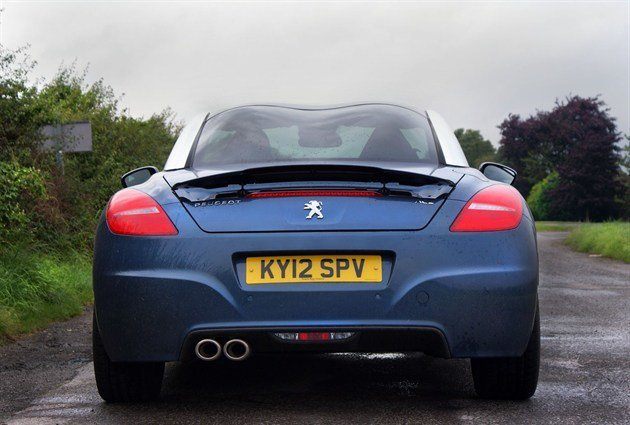
A MINI Adventure. To the tip.
It's hardly the biggest car, but loading the MINI Coupe up with rubbish showed that it isn't as impractical as you might expect.

Date: 18 October 2012 | Current mileage: 4015 | Claimed economy: 65.7mpg | Actual economy: 51.7mpg
One of the (few) benefits of living in a tiny London flat is that there is no room for junk. That means it’s not too difficult to have a mass clear out and get rid of stuff. It also means a little Coupe isn’t too much of an obstacle – less stuff to discard, less space required to convey it to the dump.
That said, the MINI is surprisingly capacious given its sporting credentials. While most two-door coupes have a ‘boot’ rather than a hatchback, the Coupe has the latter, along with a pair of parcel shelves that can both be removed. This means I can carry three bin sacks, the boxes for two pieces of flat-pack furniture and a desktop PC case without any difficulty.
It wasn’t a perfect trip, though – I had to leave behind an empty wine case and a couple of empty boxes. That’s not all down to the car, though – I have particularly poor packing skills and could very probably have fitted them in with a little more effort. Even so, it’s hardly the best car in the world for regular rubbish runs – but that’s not really what it’s meant for.
There are a few other irritations, too. I recently ran my iPod through the wash and it’s gone to Apple heaven, so I’ve been using the radio. That’s fine most of the time, but the DAB system seems to have stored the radio stations for the full length of Britain, so it takes an age to scroll to the local area. It’s probably a setting I’ve picked incorrectly, though, because I don’t remember it being that way before. Something to look up in the handbook when I get a spare moment.
The only other problems that have presented themselves lately are minor – there was a rattle from the parcel shelf over rough surfaces that decided to go away on its own, and the centre arm rest gets in the way of the handbrake, so it’s a pain in heavy traffic.
Otherwise, it’s still the same – excellent fun and a real attention grabber. Since it arrived it’s been the centre of attention everywhere I’ve taken it. That’s down, in no small part, to the striking colour scheme, which is the best I’ve seen on a Coupe (in my opinion, of course). People stop and stare, hover alongside on the motorway and - in the case of car wash staff - compete to be the ones to clean it.
It’s still a very rare car too. In my time with it I’ve seen just two others on the road, one in a burnt copper colour and another in an identical scheme to mine but with the addition of front spotlights, which looked either out-of-place or really good, I’ve just not decided which.
Cross Country
The diesel engine makes our MINI Coupe a good blend of fun sports car and long distance cruiser - so we've taken it from coast-to-coast to see just how well it copes over mile after mile of mixed roads.
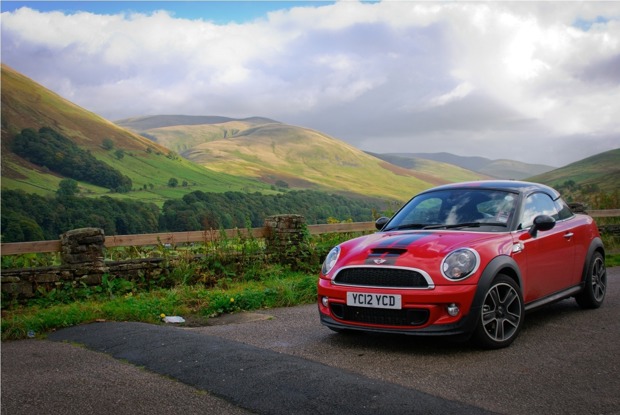
Date: 30 October 2012 | Current mileage: 4873 | Claimed economy: 65.7mpg | Actual economy: 51.5mpg
The MINI Coupe is billed as a sports car, but thanks to the diesel engine in our SD, it’s also economical. It offers reasonably quiet comfort on a long journey, helped by the fairly refined engine and good seats. It’s ideal for a big road trip – so we decided to take it on one. Starting on the west coast in Cumbria we planned a route that took in some of the country’s finest scenery, crossing the Lake District, Yorkshire Dales and Yorkshire moors and coast.
It wasn’t just a fun cross-country trip though – the route takes in a mixture of straight roads, dual carriageways, twisting B-roads and motorways, as well as tight, ancient, higgledy-piggledy towns. That said, the MINI Coupe is a fun car first and foremost, so the planned route was mostly biased toward more scenic routes
From Whitehaven the route kicked off with a stretch of the A66. It’s not the most exciting bit of Cumbrian road but it’s one of the most important, linking west and east. We could have done more or less the whole journey on it – but that would have been boring. Luckily the Whinlatter Pass, which leads down into the heart of the Lake District, is a little more entertaining, snaking through alpine woodland towards Keswick.
It’s on roads like this that the MINI Coupe feels its best - the gearbox is slick, the steering is well weighted and there’s plenty of torque to make the few straight sections of road more entertaining. Lakeland roads are generally pretty well maintained too, so there are few potholes and ripples. That made the sweeping waterside route along Thirlmere and towards Windermere all the more enjoyable, but when we crossed over into Yorkshire a few problems made themselves apparent.

Sadly, the same level of care isn’t put into the Dales roads, which are rippled, uneven and potholed. Here the MINI’s firmness is a detriment to comfort, with a lot of noise over bumps and a tendency to become a little unsettled over the roughest stretches. Luckily it has to be very rough indeed to seriously hamper the drive. The scenery is different in the Dales too, with fewer rocks and less dramatic hills – but it’s still incredibly beautiful.
Yorkshire is the largest county in England and has two national parks within its borders, the Dales in the west and the Moors in the east. Sadly the bit in between the two is fairly bland – it’s largely flat, but at least it’s still green. This is where we took to the motorways and dual carriageways, on which the MINI works well. It’s quiet in sixth gear, has cruise control and is fairly comfortable. There’s also DAB radio and iPod connectivity to help relieve boredom.
The final stretch took us down the coast from Redcar to Whitby, driving through small coastal towns. Redcar itself is currently being redeveloped and in the resulting traffic the MINI was a mixed bag. The clutch isn’t too heavy but when in stop start traffic it can make for sore ankles. Visibility at junctions and traffic lights isn’t great either because of the low roofline, although that’s something you get used to – it just makes you extra cautious.
Our trip finally ended in Whitby, after about 170 miles of mixed roads and scenery. We didn’t arrive in a storm, like Dracula plus we managed to get parked pretty easily despite the lack of spaces in the town. We’ve already ascertained the MINI’s strengths in previous updates, but this journey tested most of the road types you’re likely to encounter. It coped pretty well – it’s great fun when you want it to be, comfortable on the motorways and managed 51.5mpg over the trip.
But in town it’s a little bit awkward to see other road users and the clutch can get a little heavy. On top of that, if you ever go on an epic sightseeing trip you’ll only be able to share the view with one other person - there are only two seats. On the plus side that means there’s a pretty useful boot, so if you’re going away to somewhere like the Lakes you can take all of your luggage – and your car will still feel special even among some of the best scenery the country has to offer.
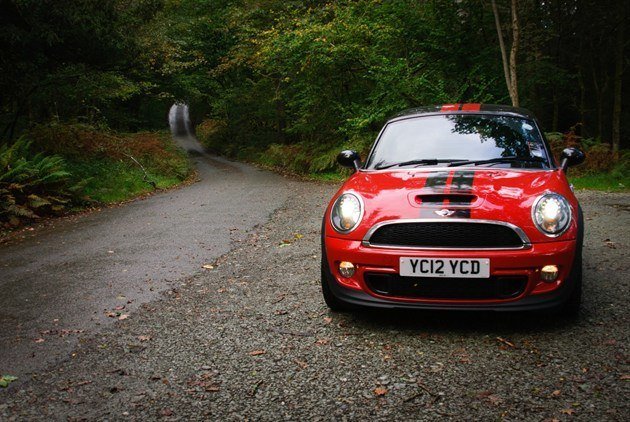
1959-2012: A Mini history
We take a brief look at the history of Mini and the myriad models made between 1959 and 2012.
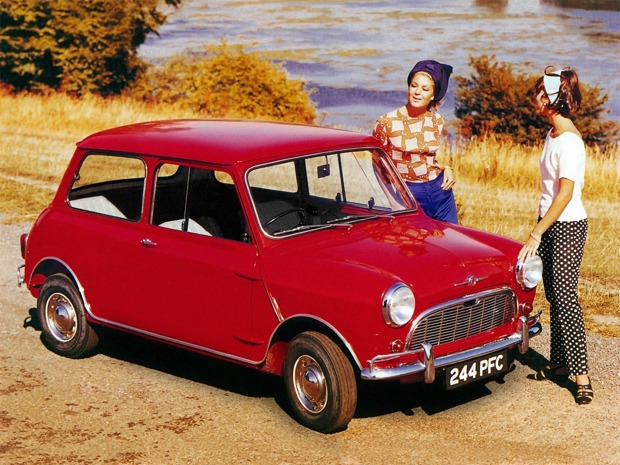
Date: 5 November 2012 | Current mileage: 5088 | Claimed economy: 65.7mpg | Actual economy: 51.8mpg
Our MINI is part of a surprisingly broad range of models covering a lot of different niches. As a range it has exploded in size over the past few years. You might think this is a new thing but the original Mini had a fair few variants too, although some were built by independent companies. Here’s a few of my favourites:
1959 BMC Mini

In 1959 the first Mini went on sale. It was a revolutionary design thanks to its front-wheel drive layout, which saved space in the cabin for passengers and made it possible to shrink the footprint of the car. The same basic front-wheel drive layout is still used by most small cars today. The original was powered by a tiny 850cc engine, but as the car evolved it got bigger engines including the 1275cc used in the Mini Cooper.
1960 Mini Van/ 1961 Mini Pickup

As the name suggests – this was a longer version of the Mini with a van body. It didn’t matter that it was a van – members of the public still bought it and used it as they would a car. There was also a Mini pickup, which was simple but sparsely equipped.
1961 Riley Elf/ Wolseley Hornet
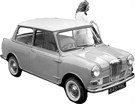
You’ll recognise this as a Mini, but a little different – it has a boot. Technologically it was fairly similar to the Mini, but slightly more plush and luxurious inside with more loadspace.
1961 Morris Mini Traveller/ Austin Mini Countryman

The Traveller/ Countryman was an estate version of the Mini. Longer than a normal Mini it was available with or without wood decoration. The rear doors opened outward rather than upwards, a feature that has made it into the modern incarnation of MINI Clubman. Why two names? Because there were two different marques – Morris and Austin.
1962 Ogle SX1000

It might not look like a Mini, but beneath the sleek bodywork, the Ogle SX1000 is based on a Mini chassis with a Mini engine. It was one of scores of small kit cars based on the Mini which perhaps are the only real ancestors to the modern MINI Coupe.
1964 Mini Moke

It looked like a cross between a Mini and a Jeep – and that’s because it was first developed for potential military use. It never made it that far but become popular with the public. It looks perfectly in place cruising along a seafront on a summers day.
1969 Mini Clubman

This was not an all-new Mini, but rather an alternative take on the style. The squared off front end was in keeping with style of the era. It was sold alongside the more recognisable 1959 shape model, but the Clubman range had more equipment.
2001 MINI Hatch

Through tumultuous times in the British motor industry the Mini marquee changed hands a few times but the car itself soldiered on, through constant changes and upgrades, until 2000. By this time, BMW had taken over the rights and had developed the new model. Much larger and more modern, it proved popular because of its combination of modern build coupled to retro styling.
2004 MINI Convertible

The first move by BMW owned MINI into a new niche, the convertible features a fabric roof that folds behind the small rear seats. Besides that it’s pretty much a MINI hatch, albeit with some strengthening to keep it rigid. A convertible variant of the current generation MINI was added to the range in 2009.
2007 MINI Hatch

MINI launched an all-new model in 2007, although it looks more or less the same as the 2001 model. Improvements across the board were included and plans were afoot to broaden the range significantly, with new models based on the 2007 MINI platform.
2008 MINI Clubman

Like the 1961 Countryman, this is a small estate version of the MINI with a split rear tailgate. It’s not massively spacious but it does make the MINI viable for those who need a bit more room. It also forms the basis of the 2013 Clubvan, which has the rear seats removed and the windows blocked out for commercial use.
2010 MINI Countryman

With crossover models and SUVs gaining popularity, MINI introduced the Countryman. While it has usual MINI styling cues it’s much larger and taller. The Countryman was the first MINI model to have five doors, but a two door version called the Paceman has been launched too.
2011 MINI Coupe

With its low roof and two-seat design the MINI Coupe aims to be a sports car and for the most part it delivers. Our 2.0 Cooper SD diesel model has a good turn of pace and precise, enjoyable handling.
2012 MINI Roadster

What if you want the two-seat, sports car drive of the Coupe with wind in your hair? MINI has the answer. The Roadster is fundamentally a soft-top version of the Coupe, but the practicality of the boot is sacrificed somewhat. The styling is less likely to divide opinion though.
2013 onward?

MINI continues to diversify and add new models to the range, the latest of which is the Paceman – a two-door Countryman. An all-new version of the hatch is due soon and will spawn new generations of the Coupe, Convertible, Clubman and Countryman.
Winter arrives
The cold sets in and the adverse weather reveals some different behaviour from our MINI Coupe.
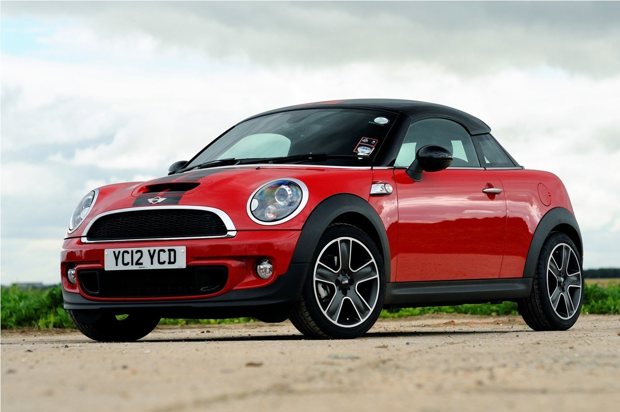
Date: 26 November 2012 | Current mileage: 5782 | Claimed economy: 65.7mpg | Actual economy: 52.8mpg
In case you haven’t noticed, it’s cold. Cold weather does strange things to a car, changing everything from the way it consumes fuel to the flexibility of the tyres. What can be a lovely car during the summer can be a nightmare in the winter. What can you expect from a MINI Coupe in the cold weather?
As our car is a diesel it can take a little while longer than a petrol car to warm up. This is down to the thermal efficiency of a diesel engine, which produces less waste heat. So the heated seats on our MINI are extra handy as they take no time at all to warm up. Unlike some that stay on, they turn off for a short while and then reactivate when they cool down, so there’s always some heat in the seat.
Another downside to the amount of time it takes to warm up the car is the screen steaming up – you have to blast it with cold air to get it clear because it takes a good few minutes until warm air comes through and that means an uncomfortable start to a journey first thing in the morning.
The rear screen clears fast enough but with no rear wiper it’s impossible to clear rain off. The big spoiler at the back tends to keep rain off when on the move, even if it’s torrential, so the only time it’s irritating is when you start a journey.
Whether down to the improved thermal efficiency or not, the fuel economy has improved ever so slightly in the cold weather. I’d hesitate to attribute it to the temperature – it’s likely down to driving more slowly in poorer conditions and through the darkness.
Another thing that’s noticeably changed is the traction from the front wheels. With lower temperatures the rubber in tyres tends to be stiffer – I haven’t had winter tyres fitted this year and with hefty 305Nm of torque it's easy to inadvertantly break traction with the front wheels when pulling away.
Luckily the car keeps me appraised of potential risks – there’s an audible warning if the temperature drops to 3 C, accompanying a little snowflake and an ice warning message. It’s very clear and stays on screen for long enough to ensure you spot it.
The flooding has caught me out once, when I missed a patch of standing water around a bend and hit it at speed. It wasn’t deep, luckily, but the wheel arch liners popped out of placed very slightly. All it took to fix it was a quick poke.
If the car was staying with us for the duration of winter I’d have got some winter tyres fitted, but it’s almost time to say farewell to the MINI. It’s quite a powerful car and in snow or ice winter tyres would make a difference – but living in London and spending most of my time on major roads means I’ve missed any snow so far. Hopefully that will continue into the new year!
We'll configure it out
With such a massive range of colour options and combinations it's well worth using the MINI configurator to specify your car.

Date: 3 December 2012 | Current mileage: 5992 | Claimed economy: 65.7mpg | Actual economy: 52.8mpg
When ordering a car you will likely sit down in the showroom and look at a collection of paint samples and fabric swabs. With a MINI there’ll be a few more things to pick out, like door mirror caps, alloy wheels, stripes and interior trim details. It’s a pretty endless list and when you come to ticking boxes you might have no idea what the finished car will look like.
Thankfully there’s a pretty comprehensive configurator on the MINI website and it’s well worth using ahead of a visit to the showroom so you know exactly what your MINI is going to look like when it’s built. The styling is quite sensitive to colour choices and with such a broad spectrum of customisation options it’s a good idea to experiment – we’ve had a play and come up with both good and bad ideas.

Our MINI Coupe is red with black details. Keeping it simple has meant quite a stylish result – the stripes, roof, wheels, interior trim and headlights surrounds are all black while the paintwork and interior details are red. It’s a striking combination.
Unfortunately it’s easy to make a less cohesive model like that below. Mixing silver with orange and black just doesn’t looks quite as good,. Styling is, of course, very subjective, so you might love it – but it’d probably look better with silver wheels and silver stripes, which is why playing with the configurator is better than simply picking from a chart.

MINI models are usually dressed up with contrasting stripes or a different coloured roof, but the design below is all one colour. It has stripes, but they’re black too, as are the headlight surrounds and wheels. It’s less outrageous but no less striking – like a stealth fighter. It’s not a colour scheme many would choose when presented with such a breadth of colourful options, but it’s pretty good looking.
There are plenty of options besides paint colour, including different layouts for the stripes, different designs for the alloy wheels and different trims for the seats and dashboard. It’s worth asking about popular combinations if you’re going to sell your car in a few years. An undesirable model won’t be worth as much on the used market as an attractively styled one.
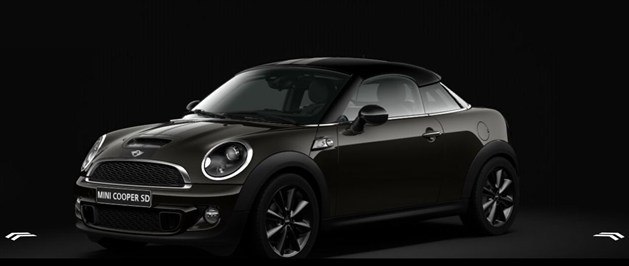
The most important thing, of course, is to design a car you like – and the configurator is the perfect tool, not just for designing the car you’re going to buy but for procrastination! The whole range is there and it’s easy to spend more than an hour trying to build up a super basic or incredibly pricey model.
Get lost
The sat nav in our MINI Coupe proves to be either a godsend or a massive pain depending on where the car is.

Date: 17 December 2012 | Current mileage: 6401 | Claimed economy: 65.7mpg | Actual economy: 51.8mpg
The infotainment system on our MINI Coupe features iPod connectivity, Bluetooth, radio controls and of course - sat nav. An in-built system is good for several reasons – it never needs charging, it doesn’t leave marks on your windscreen, it gives directions through the car speakers and it has a big screen.
So far the system in our car has been pretty good – it accurately predicts an estimated arrival time, it’s easy to input destinations and it’s very clear and simple to understand. However, over the past few weeks it’s been a bit like clumsy friend – it means well but it just makes things worse.
As the nights draw in and the weather deteriorates it’s been nigh on impossible to make a journey without getting delayed by heavy traffic or accidents. The sat nav knows when there has been an incident on the route and lets you know with a warning on screen.
I’ve used a few sat navs in the past and haven’t trusted them to be accurate with accident reports, so initially I chose to ignore the warnings and suggestions of redirection. For minor delays that’s fine, but after a major incident on the M40 it backfired. The result was an hour of waiting to cover two-miles of motorway.
After that afternoon of frustration I chose to pay heed to any future warnings on the sat nav. A week later it told me of a long delay on the M1, but as it couldn’t suggest any sensible alternative routes I ploughed on, only to become trapped in stationary traffic for around four hours. People were wandering the carriageway such was the delay.
During my time stuck in the jam I discovered an auto-reroute feature in the nav which changes the route based on traffic. On my next trip, trusting its judgement, I took an exit and drove up an unfamiliar road, which I followed for 30 minutes or so. The result was promising - my arrival time was only two minutes later than it had been before the detour.
That was until the sat-nav lost the road I was on because it had been reconstructed a few yards to the left of where it once was. The nav then simply stopped offering me directions, causing me to get completely lost for 20 minutes. I became even more frustrated when the incident that caused the detour cleared up while I was still finding my way.
So now I’ve turned the auto-reroute feature off and I’ve resigned myself to the fact that traffic problems, while annoying, are usually pretty unavoidable. That’s fine, though, because if you take traffic jams out of the equation the MINI’s sat-nav system is among the best I’ve ever used.
Made in England
The MINI Coupe is made in England - just like my other car. But that was built in 1974. What's changed in 38 years?
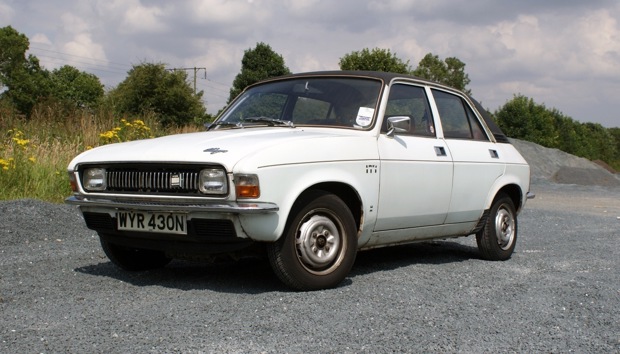
Date: 8 January 2013 | Current mileage: 7362 | Claimed economy: 65.7mpg | Actual economy: 51.7mpg
Despite the MINI brand being owned by BMW Group most of the MINI range is still built in Britain. Our Coupe is among the models constructed in Cowley, Oxfordshire. Interestingly my other car was also built in Britain, albeit 38 years ago...
Yes, the Austin Allegro pictured - a 1300 SDL Auto - is mine. The Allegro was first introduced in 1973 and evolved into the Series 2 and Series 3 over its lifetime, but my car is an early Series 1. It’s a simple machine and it’s not what you’d call pristine, but it’s fairly solid and reasonably reliable.
The A-Series engine, which was fitted to the original Mini among other things, is only good for 55PS, which means performance is lethargic. The four-speed automatic gearbox is fairly smooth, but there's plenty of noise at anything above 50mph, so it's not exactly ideal for keeping up with modern traffic.
The interior is a far cry from the soft-touch, ambient-lit cabin of the MINI. There’s vinyl on the seats, an AM radio with a mono speaker and wind-up windows - that's it. In the modern world it’d be nice to have a proper FM radio, but aside from that, when on the go it feels perfectly fine.
It makes you wonder how much of the gadgetry on a modern car is truly needed. The MINI has sat-nav, DAB radio, mobile phone connectivity, fuel economy read outs, iPod and Aux-in, lumbar support... they’re all nice, of course, but are they necessary?

That said, some modern technology advances are worthy. Safety equipment in the Allegro consists of two seatbelts and some crumple space in front of the tiny engine. There are no belts for the back seats, the steering has no power assistance, there’s no ABS, no traction control and no airbags. Luckily I haven’t had an accident and I hope I manage to avoid one.
When the Allegro was launched it had a high-tech new suspension system called hydragas, which doesn’t have springs and shocks. The system was designed by the late Alex Moulton OBE, a pioneering engineer who recently passed away. You can read more about Moulton and the Hydragas suspension system on our sister site, AROnline.
As pioneering as the system was it does have its issues on a modern road. The Allegro doesn’t roll around in bends, like you might expect, but present the car with a speed bump and all the work usually done by the suspension is done by the seats. It gets pretty bouncy. The hydragas system did evolve, though and was eventually fitted to the MGF sports car.
There are some things that were better in the good old days though - like visibility. Thin windscreen pillars and a huge amount of glass mean that you can see all around – that’s not the case with the MINI nor with most modern cars, which have thicker pillars to give better rollover and side impact protection.
On a few occasions I’ve commented on how much attention the MINI gets. But the Allegro gets even more. It gets just as many stares, but on top of that scores of people walk up and ask questions. It seems to bring back fond memories from owners of old British Leyland cars.
British Leyland itself may be a memory, but British manufacturing is still booming. Jaguar, Land Rover, MINI, Toyota, Nissan and Vauxhall all produce cars in the UK. The sheer number of manufacturers in the country may be lower, but the industry keeps thousands of people in employment.
Not only that but UK factories produce some excellent cars, including our MINI Coupe. 38 years after my tatty Allegro rolled off the line, it seems Britain still has it. The models made in this country have evolved with the times and are still good enough to take on the rest of the world.
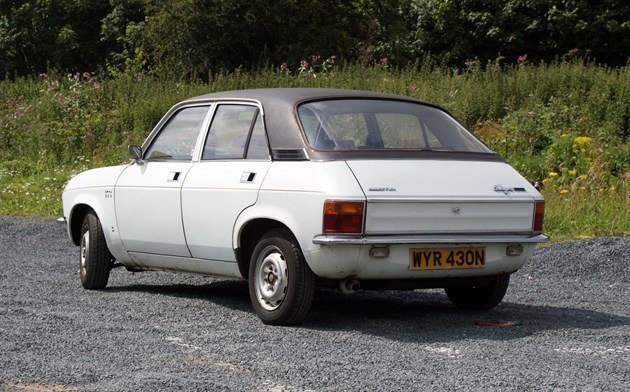
A fond farewell
The MINI Coupe leaves us after an enjoyable six months and the good news is that it's been excellent for the most part.
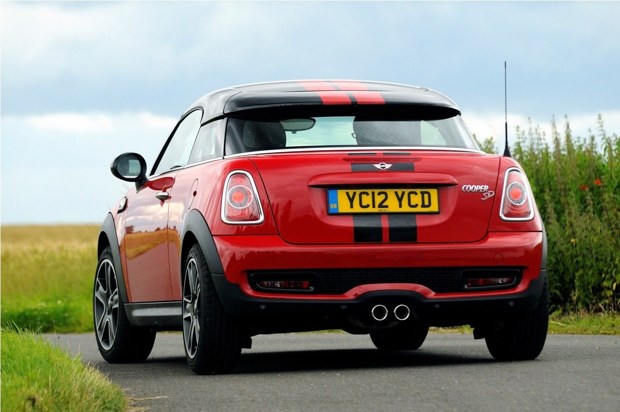
Date: 30 January 2013 | Current mileage: 8214 | Claimed economy: 65.7mpg | Actual economy: 51.9mpg
It's time to say goodbye to our MINI Coupe after six months. It's a car i'm going to miss and one I've enjoyed thoroughly. Of course like all good friends, it’s not been perfect. Our MINI was a diesel which is good for fuel economy, but a little lacking in charisma. A little sporty car like the MINI Coupe should sound good but where the Cooper S version fizzes and pops, ours sort of chugs along.
It has also been a bit of a pain due to its two-seat layout. I’ve only ever been able to carry one passenger, which is fine most of the time but tremendously annoying the rest. Other coupes like the Volkswagen Scirocco and Peugeot RCZ have little uncomfortable seats in the back, but at least they’re there. There's nothing in the MINI.
Having said that, there is a plus side to the lack of rear seats – the boot is pretty useful with space for a couple of suitcases. Unlike some coupes it has a hatchback tailgate too, so access is easy. There’s even a 12v charging socket and if you have awkward stuff to carry, a ski-hatch.
On the whole, the cabin is great. It has an interesting layout and nifty touches, but there are some questionable materials in the centre-stack and the controls for air con, radio and the like took some getting used to. Yet despite the cars’ flaws, it has managed to make me smile on nearly every journey
There’s a big chunk of torque – 305Nm in fact, which is more than a Porsche Boxster – and it's available from low down the rev range. That makes acceleration impressive and means overtaking slower traffic is an absolute doddle, requiring little more than a flex of the right foot. The steering’s good too – pointy and precise – making country lanes fantastic fun.
The MINI also has a great infotainment system with a good sat nav, Bluetooth, DAB radio and crisp, bassy speakers. There's plenty to keep you entertained on a long motorway journey, where the absence of an engine note is a treat rather than a problem and cruise control helps fuel economy and keeps ankle-ache at bay.
And then there’s the styling. It's not to everyones liking but the looks grew on me very quickly. Initially I was extremely self-conscious, given the number of staring pedestrians, but it’s something you get used to. My neighbour exclaimed that the little MINI was ‘king car in the street’ shortly before it went – and the street has a Land Rover, a Mercedes-Benz and even a Bentley.
Unfortunately that unique styling creates another of the MINI’s problems – poor visibility. The roof pillars are steep and long, obscuring vision at junctions. The rear view is equally poor, while rear three-quarter visibility is downright terrible, making oblique junctions tricky to emerge from. That said, the rear view mirrors are fine and alleviate the frustration somewhat.
It’s a shame to say goodbye to our MINI Coupe. It’s been a faithful and enjoyable companion for the past six months. With the respected MINI badge up front, unique styling, enjoyable handing and a good engine range it’s a fantastic choice for someone who wants to stand out from the crowd.
Keen drivers will want the Cooper S or JCW models, which have wonderful exhaust notes and feel more involving on the road, but for those who cover lots of miles the SD diesel is a flexible, economical and a strong performer.
To see exactly where our MINI Coupe has been in the past six months and how it has performed on different roads and journeys, click the coloured lines on the interactive map below.

